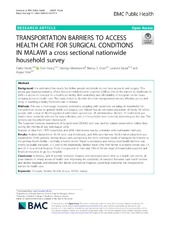| dc.contributor.author | Varela, Carlos Gomes | en_US |
| dc.contributor.author | Young, Sven | en_US |
| dc.contributor.author | Mkandawire, Nyengo | en_US |
| dc.contributor.author | Groen, Reinou S. | en_US |
| dc.contributor.author | Ngoie, Leonard Banza | en_US |
| dc.contributor.author | Viste, Asgaut | en_US |
| dc.date.accessioned | 2020-04-06T08:37:15Z | |
| dc.date.available | 2020-04-06T08:37:15Z | |
| dc.date.issued | 2019-03-05 | |
| dc.Published | Varela V, Young S, Mkandawire N, Groen, Ngoie LB, Viste A. Transportation barriers to access health care for surgical conditions in Malawi: a cross sectional nationwide household survey. BMC Public Health. 2019;19:264 | eng |
| dc.identifier.issn | 1471-2458 | |
| dc.identifier.uri | https://hdl.handle.net/1956/21692 | |
| dc.description.abstract | Background: It is estimated that nearly five billion people worldwide do not have access to safe surgery. This access gap disproportionately affects low-and middle-income countries (LMICs). One of the barriers to healthcare in LMICs is access to transport to a healthcare facility. Both availability and affordability of transport can be issues delaying access to health care. This study aimed to describe the main transportation factors affecting access and delay in reaching a facility for health care in Malawi. Methods: This was a multi-stage, clustered, probability sampling with systematic sampling of households for transportation access to general health and surgical care. Malawi has an estimated population of nearly 18 million people, with a total of 48,233 registered settlements spread over 28 administrative districts. 55 settlements per district were randomly selected for data collection, and 2–4 households were selected, depending on the size. Two persons per household were interviewed. The Surgeons Overseas Assessment of Surgical need (SOSAS) tool was used by trained personnel to collect data during the months of July and August 2016. Analysis of data from 1479 households and 2958 interviewees was by univariate and multivariate methods. Results: Analysis showed that 90.1% were rural inhabitants, and 40% were farmers. No formal employment was reported for 24.9% persons. Animal drawn carts prevailed as the most common mode of transport from home to the primary health facility - normally a health centre. Travel to secondary and tertiary level health facilities was mostly by public transport, 31.5 and 43.4% respectively. Median travel time from home to a health centre was 1 h, and 2.5 h to a central hospital. Thirty nine percent of male and 59% of female head of households reported lack financial resources to go to a hospital. Conclusion: In Malawi, lack of suitable transport, finances and prolonged travel time to a health care centre, all pose barriers to timely access of health care. Improving the availability of transport between rural health centres and district hospitals, and between the district and central hospitals, could help overcome the transportation barriers to health care. | en_US |
| dc.language.iso | eng | eng |
| dc.publisher | BioMed Central (BMC) | eng |
| dc.rights | Attribution CC BY | eng |
| dc.rights.uri | http://creativecommons.org/licenses/by/4.0/ | eng |
| dc.subject | Transport | eng |
| dc.subject | Barriers | eng |
| dc.subject | Health | eng |
| dc.subject | Access | eng |
| dc.subject | SOSAS | eng |
| dc.subject | Survey | eng |
| dc.title | Transportation barriers to access health care for surgical conditions in Malawi: a cross sectional nationwide household survey | en_US |
| dc.type | Peer reviewed | |
| dc.type | Journal article | |
| dc.date.updated | 2019-12-10T18:48:01Z | |
| dc.description.version | publishedVersion | en_US |
| dc.rights.holder | Copyright 2019 The Author(s) | |
| dc.identifier.doi | https://doi.org/10.1186/s12889-019-6577-8 | |
| dc.identifier.cristin | 1705115 | |
| dc.source.journal | BMC Public Health | |

